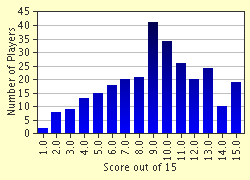Quiz Answer Key and Fun Facts
1. This early Christian martyr is known by his full name as well as a "nickname". He shares his full name with an eminent Dutch scholar of the Renaissance. He shares his nickname with a cute fuzzy red monster from Sesame Street. He is the patron of sailors because, according to a medieval legend (let's hope it was only a legend!), he was tortured by having his entrails extracted using a windlass. A strange light that plays around the masts of ships before a storm is named after him. I'm giving his full name and his nickname.
2. Another early Christian martyr is the patron of actors and dancers. He is invoked against a spasmodic affliction which bears his name.
3. This Biblical saint, who was kept quite busy during his lifetime, is the patron of two of the world's largest countries: China and Canada. He is patron of Canada along with St. Anne, to whom he is related by marriage.
4. The traditional patron saint of lovers is, of course, Saint Valentine. Lovebirds, however, also have an angelic patron in this archangel, who "played Cupid" for Tobias and Sara.
5. The traditional primary patroness of musicians, composers, and singers has always been St. Cecilia, though her story is largely based on legend. However, this pope of the 6th century is also venerated as the patron of musicians, having given his name to an entire school of Church music.
6. St. Patrick's day is the traditional "Great day for the Irish". However, this female saint was once more widely venerated than Patrick. She was known as the "Virgin Mary of the Gael" and, unlike Patrick, was Irish by birth.
7. Artists have traditionally prayed to St. Luke who, according to doubtful legend, painted the first Madonna and child (from life). More recently, however, this "angelic" artist, who was also a monk, has been been beatified and may soon be elevated to sainthood.
8. G'day mates! The principal patron saint of Australia and New Zealand is none other than the Virgin Mary herself. But under which of these titles is she venerated in the land down under?
9. The Three Magi, or Wise Men, are among the patron saints of travelers.
10. St. Denis, who was beheaded and is sometimes depicted holding his severed head in his hand, is one of the saints invoked to cure headaches. Those desiring a less drastic cure may wish to pray to this sixteenth century Spanish prioress and spiritual author, who was much admired by, among others, Gertrude Stein.
11. There is, believe it or not, a patron saint of drug addicts, who certainly need all the spiritual help they can get. Their patron is this twentieth century priest who died as the result of a lethal injection.
12. People suffering from venereal disease also have a patron saint in this Irish monk, who is also the patron of gardeners and taxi drivers (French taxis are named for him).
13. This Italian abbess and founder was bedridden one Christmas and could not attend the Christmas Matins. Miraculously, on the wall of her sickroom, she received a vision of the entire ceremony as if it were a television or movie screen. Because of this, she is the patroness of all who work for, or on television. Who is she?
14. You might have thought this saint was the patron of doctors, since a fictional television hospital was named after him. Actually, he was a metalsmith by trade and is the patron of that profession, as well as of jewelers and bankers.
15. Which of these apostles is one of the patrons of Russia? (He is also patron of Greece and Scotland.)
Source: Author
jouen58
This quiz was reviewed by FunTrivia editor
thejazzkickazz before going online.
Any errors found in FunTrivia content are routinely corrected through our feedback system.

